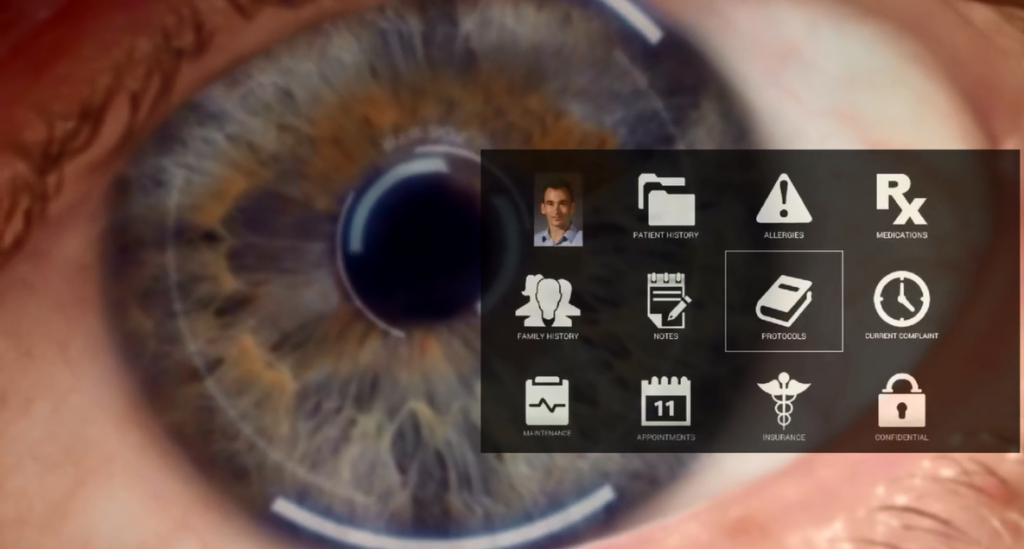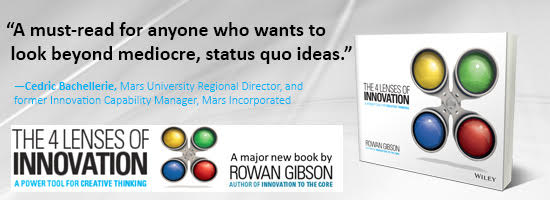The Wearable Foreseeable Future of the Workplace

Workplace Implications of Eye-interaction Technology in AR and VR headsets:
As augmented reality and virtual reality technology advance, AR and VR headsets are, or will soon be, entering the workplace.
Enterprises are scrambling to establish a competitive edge through the use of these glasses, goggles, and phone carriers, and pilots are rolling out globally in factories, construction sites, hospitals, and offices.
There are two major takeaways from these early pilots. First, employees critically value the comfort and wearability of headsets. If they’re too heavy, too hot, or an impediment to the user’s normal behavior, users simply will not use them. Second, user interaction with the headsets through head motion, hand gestures, and voice is inadequate.
So how about the eyes? Up until now, the only methods of interacting with information or controlling objects with your eyes was based on staring and waiting (dwelling) or winking or blinking to emulate a “mouse click.â€
But a new interaction model has been developed — based on the biomechanics of the eye and the eye-brain connections — that enables virtually instantaneous interaction simply by looking.
The implications of eye-interaction technology in AR and VR headsets for employees are extraordinary.
There are four areas in which eye-interaction technology will profoundly impact workers:
(1) Productivity
Eye interaction transforms a user’s intent into action through their eyes without requiring head motions, hand motions, or speaking. This means that the 40 million desk-less, hands-free workers in the U.S. — and hundreds of millions more around the world — will access remote information, survey constructions sites, or complete quality assurance checklists as fast as they can think and look. And considering that the brain can process images in about 13 milliseconds, productivity and efficiency will naturally speed up. So a surgeon can assess the condition of the heart simply by looking at the heart and invoking a menu of options with her eyes.
(2) Intelligence
Eye interaction in a virtual environment of 20 simultaneous screens around a user’s head, navigable simply by thinking and looking, provides more information to a user than ever thought imaginable.
A researcher can cut and paste key text, graphs, and images into an eye-controlled clipboard, overcoming short-term memory limits, to improve human working memory — which is a proxy for intelligence — and boost a user’s IQ in solving problems. With the eye’s ability to move between locations in tens of milliseconds, the speed of collection is much faster than moving a mouse.
(3) Security
The pattern of your iris is the best biometric identifier available if it can conveniently be scanned without requiring cumbersome hardware or inconvenient gymnastics. Eye interaction is built upon eye-tracking technology, which directs a camera toward your eye at all times, that can be used to continuously validate your identity. This continuous biometric identification (CBID) may then be invoked at whatever frequency is appropriate to assure the proper level of security for a given transaction.
If you’re reading a confidential document, your identity may be validated once per minute. If you’re reviewing a top-secret government dossier, your identity may be validated once per second — or more frequently. The eye-interaction software might look at the movements of your eye and even invoke a response to ensure that it’s you and that you’re alive — and that a glass ersatz eye isn’t being used.
(4) Creativity
The combination of improved productivity and intelligence can already contribute to stimulating out-of-the-box thinking. Further, research suggests that prescribed eye movements stimulate the flow of information across the corpus callosum in your brain (the nerve bundle that connects your right and left hemispheres), which has been quantitatively shown to increase human creativity.
The difference between immersive eye interaction and basic point-and-click interfaces can’t be overstated. Imagine never needing a mouse to navigate again, as the monitor responds to the movements of your eyes. Action and your desired intent occur based on your thought and a combination of purposeful and non-purposeful eye signals.
While the underlying mechanics of eye-interaction technology are complex, its implementation is both immediately intuitive and immensely beneficial. Imagine removing the middlemen — hands and fingers — from the equation and giving your eyes the power to do what your brain wants instantly. How much more could we accomplish? What could we do that we’ve never been capable of doing before?
Employees might be wary of this evolution, especially considering that 37 percent of employees don’t trust their employers to use data from wearables — like VR or AR headsets — without prejudice. And new technology can be frightening, especially when it’s as disruptive as eye-interaction tech promises to be. However, with appropriate security and privacy, user adoption will be enthusiastic. And due to the pleasurable sensuality of the eye-interaction experience, uptake will be rapid.
Business leaders today should plan to adopt this technology to bring their workforces into the new era and maintain an edge on the point-and-click competition.
Author note: Regarding the difference between Google Glass and Eye Interaction Technology, Google Glass is a head-mounted display that employs the use of augmented reality. The software on Google Glass currently uses a combination of head movements, a touchpad, and voice control. Eye-Interaction technology, however, is a software that can be used on any head-mounted display — for virtual, augmented, and mixed reality — to enhance a person’s interaction with such devices.
image credit: eyefluence.com
Wait! Before you go…
Choose how you want the latest innovation content delivered to you:
- Daily — RSS Feed — Email — Twitter — Facebook — Linkedin Today
- Weekly — Email Newsletter — Free Magazine — Linkedin Group
 Jim Marggraff is the founder and CEO of Eyefluence, a company that is engineering the ability to transform intent into action through your eyes. Leveraging eye biomechanics and the eye-brain connection with the first-ever eye-interaction technology solution for head-mounted displays, Eyefluence is expanding human potential and empathy to create new possibilities in the virtual-, augmented-, and mixed-reality worlds. Follow on Twitter @Eyefluence
Jim Marggraff is the founder and CEO of Eyefluence, a company that is engineering the ability to transform intent into action through your eyes. Leveraging eye biomechanics and the eye-brain connection with the first-ever eye-interaction technology solution for head-mounted displays, Eyefluence is expanding human potential and empathy to create new possibilities in the virtual-, augmented-, and mixed-reality worlds. Follow on Twitter @Eyefluence
NEVER MISS ANOTHER NEWSLETTER!
LATEST BLOGS
The Incredible Shrinking Laptop
As technology advances and people’s demands for ever-thinner, ever-lighter laptops increase, more and more the thickness of a laptop is…
Read MoreA Revolution in Management Consulting?
Management consulting firms are built on a model that requires the maintenance of a bench of their people to staff…
Read More



